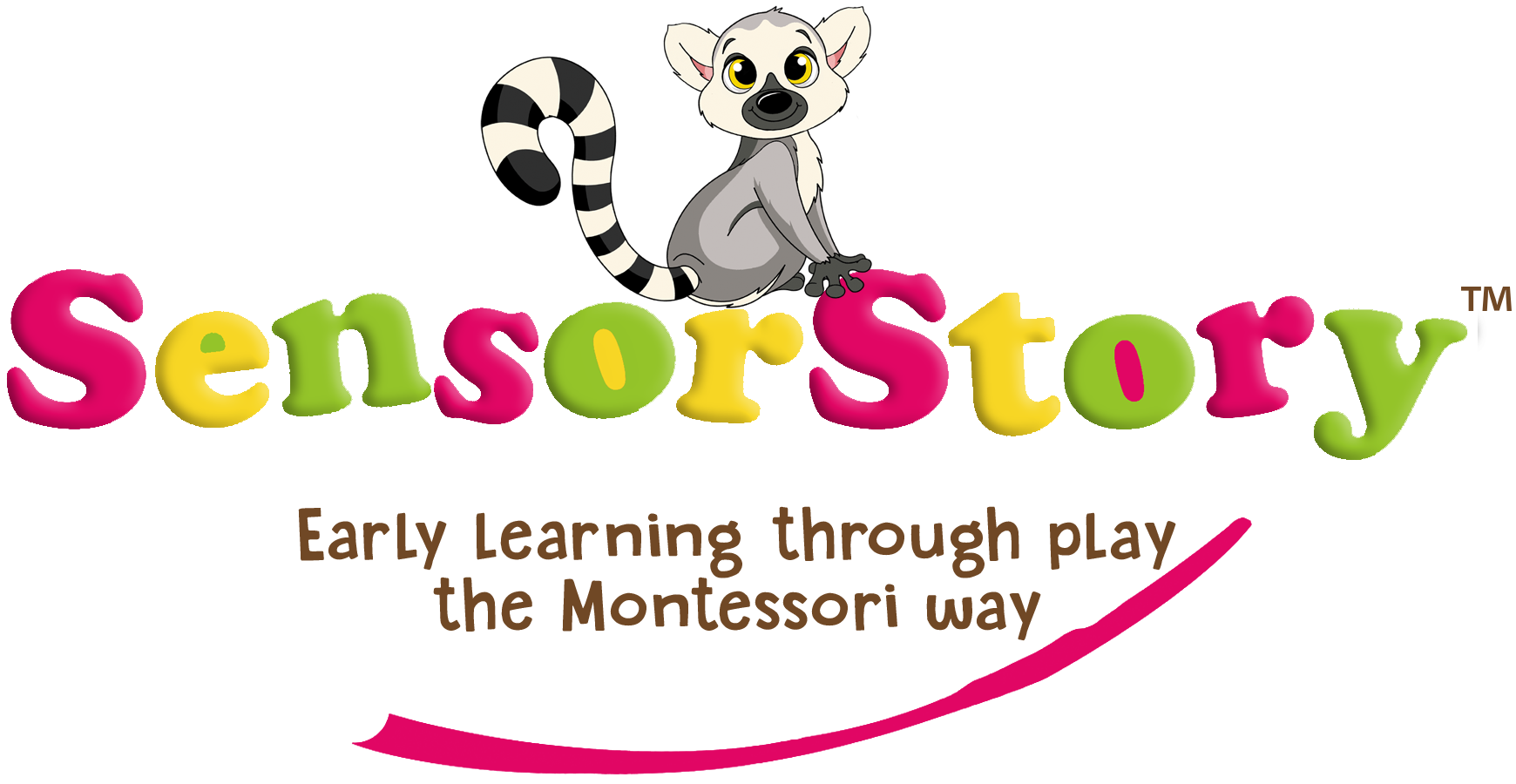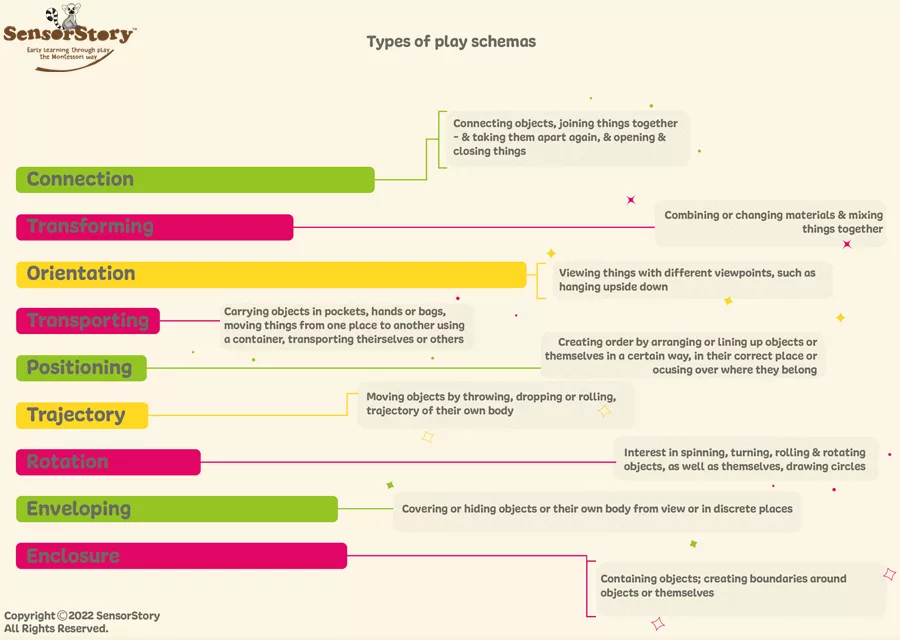While not strictly Montessori, understanding schemas is not only important for educators in order to understand their students & to adapt their curriculum, but recognising play schemas is also incredibly useful for parents. Play schemas complement & align with the Montessori method & having an understanding of play schemas as a parent can assist you in creating your prepared environment & help you introduce different Montessori Practical Life Activities that support their schema interests.
So what is a schema?
A schema is a cognitive framework that helps your little one interpret & organise information. Once a schema is created, your toddler is able to use this as a mental map in order to process similar information. Play schemas are patterns of repeatable behaviour that children regularly display to help them make sense of their world. When children display repetitive behaviours like throwing, they are developing something called a play schema. Play schemas are how children learn about the world around them & develop essential tools for interacting with that world. Sometimes you may notice that your little one is exhibiting an unwanted or quirky behaviour, such as throwing cutlery off their high chair or tipping out containers – this shows us that they are in a particular play schema – when they repeat the same behaviour over & over – in this example they are learning cause & effect, trial & error, and even the Scientific Method. Acknowledging that a particular behaviour or action is really an uncontrollable urge & that they are learning while doing it, can be helpful in more ways than one.
By recognising & then extending patterns of behaviour & thinking, we can plan an exciting & challenging learning environment to support our little one’s interests.
“Follow the child, they will show you what they need to do, what they need to develop in themselves and what area they need to be challenged in. The aim of the children who persevere in their work, with an object is certainly not to ‘learn’; they are drawn to it by the needs of their inner life, which must be recognised and developed by its means.” – Dr. Maria Montessori
There are nine types of play schema – since babies are undergoing incredibly rapid physical & sensory development, most play schemas typically appear later – most of which start to emerge in early toddlerhood, except for positioning, which typically appears closer to 2 years of age.
How are play schemas aligned with Montessori?
The Montessori method is all about intentionally crafting an environment that supports your child’s independent learning & development. Understanding play schemas will certainly help you do so! Play schemas can help us reach a deeper level of understanding of the core principles of the Montessori philosophy:
- Identifying behaviours aligned with individual play schemas can help determine Sensitive Periods, (for more information on sensitive periods, i.e., periods when your little one is ready to learn new skills, see our article What’s the deal with sensitive periods?)
- Play schemas connect to specific repeated actions & interests, which can help us design a Prepared Environment.
- Play schemas develop naturally while our toddlers engage independently to build these schemas, which is exactly aligned to the Montessori principle of Auto Education.
- Play schemas allow us to better understand some of the reasons behind our little one’s actions & instinctual behaviour, which can promote Respect for the Child (For more information on the principles of Montessori & prepared environments, see our article What is Montessori & Montessori at home)
Supporting schema play
Toddlers need opportunities to practice – If you notice your toddler working on a particular schema, you can offer toys & activities to encourage their exploration. If you observe that they love lining things up in a particular way, they will be in a positioning schema, – try giving them a few small objects, cups or farm animals, to position. Making use of floor tape is great here too, as it will give them a line to position their objects on. Schemas are developed through seemingly endless repetition that can include lots of trial & error. If your toddler is struggling to do something, let them keep trying on their own as long as they aren’t getting too frustrated.
Transporting – while your little one may have been carrying items around in their hands, around 17 – 24 months they will start to become more strategic with their transporting, using a container or basket to be more efficient. As your little one approaches 2 years of age, they are likely to start playing in more creative ways – marking the beginning of pretend play. Their imagination play is based on their own lived experiences – using their imagination to make sense of the world. (True imagination play, which involves pretending to be someone or something else, won’t start until around age 3 or 4) The difference between reality & fantasy is really blurry & wont become clearer until the age of 6. To read more about Montessori’s take on Reality vs Fantasy play, see our article Real life not fantasy.
Cause and effect – have you observed your toddler banging their spoon on the table harder & harder to see how you react – this is them investigating cause & effect. They’re noticing that they can make something happen, such as a louder & louder sound, as well as cause human reactions to their actions, for example, when I cover my eyes, mum plays “peek-a-boo” with me. It is a great idea to try to respond to your little one in the same way every time to help deepen their understanding of cause & effect. If they throw their toy off the table or their highchair, & you say “oopsie daisy” & then pick it up & return it to them, they likely will throw it again to see if you will say & do the same thing. If you respond consistently to these play invitations (which may mean repeating it somewhere between 3 and 680,344 times), your little one will learn more quickly that they have caused an effect on their environment & will encourage them to keep experimenting. Once they have mastered this skill, they will move on to a new schema, so you won’t be repeating the same response forever, don’t worry!
[vc_widget_sidebar sidebar_id=”sidebar”]

